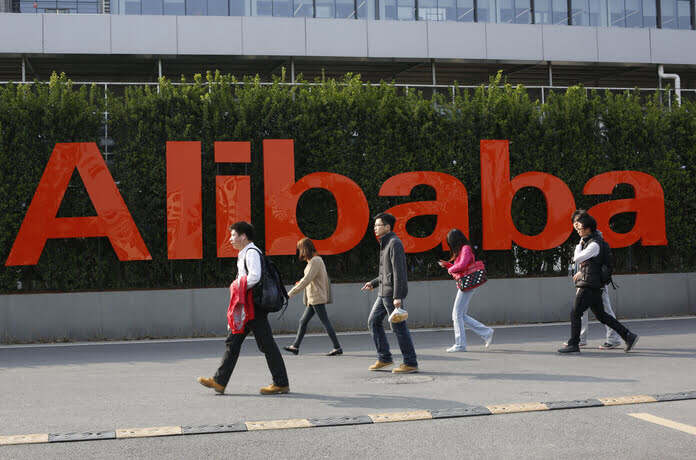Alibaba Group Holding Limited (NYSE:BABA), a titan in the global e-commerce and cloud platform arena, has seen a notable uptick in its share price, indicative of a revival in investor confidence. This resurgence follows a potentially concluding phase of governmental clampdown on the tech sector and the National Development and Reform Commission (NDRC) of China expressing a more favorable stance towards large tech stocks. This article offers an examination of the technical aspects of Alibaba stock price, aiming to predict its future trajectory and identify potential investment opportunities. It reveals that Alibaba’s shares present a significant buying opportunity at current levels, given the process of bottom formation that the price is currently undergoing.
Alibaba’s Resilience Amidst Regulatory Easing
Chinese tech stocks are experiencing a resurgence of investor interest. This comes in light of growing optimism that the government’s crackdown on the tech sector, which had dampened investor sentiment, may finally be coming to a halt. The uplift in Chinese tech stocks coincides with a broader rally in tech shares, fueled by positive inflation reports from the U.S. Alibaba’s share price has also increased its value and risen sharply, signaling renewed investor confidence in the company. This development follows a challenging period for Chinese tech stocks, with the regulatory crackdown prompting a cautious approach from investors. The recent shift in investor sentiment has been catalyzed by the NDRC of China issuing a statement that conveyed a more favorable stance towards the country’s large tech stocks.
Despite Alibaba’s recent tribulations, including a hefty $1 billion fine levied on Ant Group, a subsidiary of Alibaba, the company has demonstrated resilience. The fine served as an indication that Ant Group has satisfied the regulatory requirements necessary to restore its standing with the authorities. Coupled with new government policies aimed at reviving China’s property sector, these developments suggest a changing landscape that could be more supportive of tech giants like Alibaba.
Alibaba, being the largest e-commerce and cloud platform in China, is a formidable tech entity on a global scale. Despite a challenging past where the company’s stock price halved over a five-year period while competitors like Alphabet Inc. (NASDAQ:GOOG) doubled, the outlook for Alibaba appears promising. The company’s ability to weather the storm reflected in a modest rise in its revenue and earnings respectively in fiscal 2023, and its restructuring strategy, all point to its potential for recovery. Despite the recent difficulties, Alibaba has already started to take measures to rebuild and expand. The company reorganized its business into six distinct groups and has plans to go public with its cloud group, possibly followed by Cainiao and its Global Digital Commerce group. These spin-offs are designed to allow each segment to secure funding independently and to grow without the constraints of the parent company. This strategy is expected to mitigate regulatory scrutiny while boosting Alibaba’s revenue and earnings in fiscal 2024.
The ongoing tensions between the U.S. and China present a degree of uncertainty for Alibaba, especially considering the looming threat of delisting in the U.S. and potential restrictions on procuring advanced chips for its cloud servers. However, these factors are largely reflected in Alibaba’s stock price, which currently trades at just 11 times forward earnings. Comparatively, Alphabet, while being a dominant player, faces stiffer competition and potential disruptions to its core businesses, making Alibaba a more appealing investment option in the current landscape.
Navigating Alibaba Stock Bottom Formation Phase
Alibaba’s monthly chart showcases a tenacious bullish trend over an extended timeline. There’s a clear high point towards the end of 2020, with the stock price reaching a historic peak of $319.32, before initiating a downward trajectory. This downtrend primarily stemmed from intensifying regulatory oversight in China. The spotlight was on Ant Group, a fintech entity with significant ties to Alibaba, which was poised to execute an unprecedented IPO in November 2020. However, this was abruptly stopped in its tracks by Chinese regulators due to significant shifts in the fintech regulatory environment. This event marked a pivotal moment in China’s strategy of regulating its biggest tech companies, igniting investor concerns due to the regulatory risks for Alibaba.
Investor concerns were further escalated in December 2020, when the Chinese State Administration for Market Regulation (SAMR) initiated an antitrust investigation into Alibaba. This stirred up deeper fears regarding the impact of increased regulatory scrutiny on Alibaba’s prospects for growth, triggering a substantial fall in its stock price. Throughout these occurrences, the market’s attitude towards Chinese tech firms turned increasingly negative, intensifying the bearish trend for Alibaba’s shares.
However, Alibaba’s share price is currently undergoing a solid base formation, holding steady at lower levels. These levels offer considerable implications for long-term investments. There is an inverse head and shoulder pattern, with the ‘head’ at the 2022 low of $58.01 and the ‘shoulders’ at $73.28 and $77.77. It seems as if the price is establishing a foundation at these levels. A breakout above the neckline of these patterns at $121 might signal a substantial uptick in Alibaba’s stock prices. Interestingly, the RSI seems to be finding equilibrium at the lower end, signifying a strong market trend.
The weekly chart provides a broader perspective on Alibaba’s base formation scenario, highlighting similar patterns. There is a formation of a right shoulder, characterized by swift price reversals at $79.48, $77.78, and $82.64. These rapid reversal candles indicate robustness at the present levels, suggesting a market bottom formation. This foundation signifies the emergence of the right shoulder, set to be complete if the market continues its upward trajectory toward the $121 zone. A jump beyond $121 will shatter the inverse head and shoulder pattern, triggering a substantial market upswing.
Key Action for Investors
Viewed through the lens of an investor, it seems that Alibaba is establishing a strong foundation at its present values, with the potential for a rise in price. Yet, the certainty of a market rally is linked to the crucial point of $121. If the monthly closing price surpasses this threshold, it would be interpreted as a breakout signal, setting the stage for a potential market upswing. Considering the evolving price patterns, there seems to be a high likelihood of an upward breakout in the market. As such, the risk of initiating a long-term position at the current price point appears minimal. Anticipating higher values, investors may find it viable to venture into the market at the existing levels.
Alibaba’s daily chart presents the emergence of a triangle, which has already been broken. The price has tested this triangle, and the market appears ready for an upward move. The three bottoms at the support line of the triangle signify market strength and suggest an imminent strong rally.
Market Risk
Alibaba’s recent history demonstrates that regulatory pressures from the Chinese government have the potential to significantly impact its operations. From the halted Ant Group IPO to the implementation of stricter fintech regulations and the heavy fine levied on Ant Group, regulatory risks remain a significant concern for Alibaba. Despite recent signs of governmental softening, future regulatory actions against the tech sector in China could derail Alibaba’s recovery. Moreover, Ongoing tensions between the U.S. and China pose substantial risks to Alibaba. The potential for delisting from U.S. exchanges, coupled with potential restrictions on procuring advanced chips necessary for its cloud servers, could disrupt Alibaba’s business operations and growth prospects.
Additionally, Alibaba faces stiff competition both domestically and globally. In particular, global tech giants like Alphabet could pose significant threats to Alibaba’s market share and profitability. Although technical analysis points towards an upward breakout for Alibaba’s stock, it’s important to remember that such analyses aren’t foolproof, and the stock could fail to reach or sustain the crucial $121 mark. Any break below $58 could disrupt this technical pattern and lead to further declines.
Final Thoughts
As Alibaba navigates through the tremors of recent government regulations, investor confidence appears to be gradually restored, reflected in the resurgence of Alibaba’s share price. Alibaba’s robustness is showcased by a modest rise in fiscal 2023 revenue and earnings and strategic business restructuring to mitigate regulatory scrutiny. Even as the specter of U.S.-China tensions looms with potential implications like U.S. delisting and procurement restrictions, Alibaba stock remains a compelling investment opportunity, reflected in the stock price behavior. The technical analysis for Alibaba suggests a firm foundation is established, making a long-term investment entry at the current level an appealing prospect with low risk. Moreover, surpassing the $121 threshold would serve as a robust indicator aiming for even higher targets. Thus, investors may find it beneficial to enter the market for long-term stakes, anticipating an appreciation in the share prices.
Featured Image: Megapixl
















